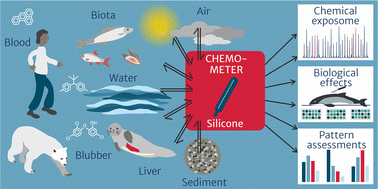Chemometers: an integrative tool for chemical assessment in multimedia environments
Abstract
We propose novel chemometers – passive equilibrium samplers of, e.g., silicone – as an integrative tool for the assessment of hydrophobic organic compounds in multimedia environments. The traditional way of assessing levels of organic pollutants across different environmental compartments is to compare the chemical concentration normalized to the major sorptive phase in two or more media. These sorptive phases for hydrophobic organic compounds differ between compartments, e.g., lipids in biota and organic carbon in sediments. Hence, comparability across media can suffer due to differences in sorptive capacities, but also extraction protocols and bioavailability. Chemometers overcome these drawbacks; they are a common, universal and well-defined polymer reference phase for sampling of a large range of nonpolar organic pollutants in different matrices like biota, sediment and water. When bringing the chemometer into direct contact with the sample, the chemicals partition between the sample and the polymer until thermodynamic equilibrium partitioning is established. At equilibrium, the chemical concentrations in the chemometers can be determined and directly compared between media, e.g., between organisms of different trophic levels or inhabiting different areas, between organs within an organism or between biotic and abiotic compartments, amongst others. Chemometers hence allow expressing the data on a common basis, as the equilibrium partitioning concentrations in the polymer, circumventing normalizations. The approach is based on chemical activity rather than total concentrations, and as such, gives a measure of the “effective concentration” of a compound or a mixture. Furthermore, chemical activity is the main driver for partitioning, biouptake and toxicity. As an additional benefit, the extracts of the chemometers only require limited cleanup efforts, avoiding introduction of a bias between chemicals of different persistence, and can be submitted to both chemical analysis and/or bioanalytical profiling.

- This article is part of the themed collection: Chemical Communications HOT Articles 2023


 Please wait while we load your content...
Please wait while we load your content...